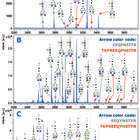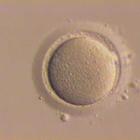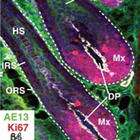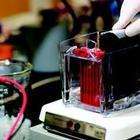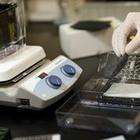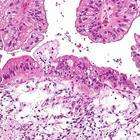FREE Email Newsletter Bioscience Technology Daily
Characterization of the N-glycosylation Pattern of Antibodies by Complementary Use of ESI and MALDI Mass Spectrometry
November 20, 2023 3:38 pm | by Jason S. Wood, PhD, Biopharmaceuticals Market Manager, Bruker Daltonics | CommentsAntibodies represent one of the most important classes of glycoproteins playing a central role in the immune response of living organisms and therefore there is a growing interest in recombinant antibodies as potential biotherapeutic agents. The detailed analysis of the N-glycosylation pattern present on antibodies is challenging due to the heterogeneous structure of this posttranslational modification.
Functional Eggs Created from Adult Female Cells
November 13, 2023 12:04 pm | by Cynthia Fox | CommentsIn a move that may end up having major impact on women, a research team has repeatedly made functional eggs— resulting in healthy live births— from adult mouse cells.
Breakthrough Human Hair Growth ‘Tantalizes’ Experts
November 12, 2023 11:17 am | by Cynthia Fox | CommentsNew human hair growth has been generated for the first time by an international team of researchers from Columbia University in the United States and Durham University in the U.K.
Cell Transplant Trials for Parkinson’s Coming
November 7, 2023 1:15 pm | by Cynthia Fox | CommentsThere was an audible gasp at the New York Stem Cell Foundation (NYSCF) conference recently when neurosurgeon Ivar Mendez showed a video of a Parkinson’s patient before and after a transplant of a fetal stem-cell like graft. The patient was affectless, and could barely move before the graft. Eight years later, he was animated and moving briskly.
Old Mice, Hooked to Young Mice, Grow Younger
November 6, 2023 1:31 pm | by Cynthia Fox | CommentsThis fall, Harvard University regenerative biologist Amy Wagers hooked up the circulatory systems of mice with multiple sclerosis (MS) to those of young healthy mice. She and a global team found that factors in the young blood prompted anti-inflammatory immune cell formation. This, in turn, actually regenerated the dying myelin sheaths wrapped around neuronal axons that are the very signature of MS.
Bolster Your Blot Confidence: Exposing Film’s Pitfalls
October 31, 2024 12:08 pm | by Ning-Liu, Bio-Rad Laboratories | CommentsChemiluminescence is the most widely used Western blot detection chemistry. And to date, X-ray film has been the most popular technique for blot visualization. Although film has been around for decades, it remains popular with researchers due to its high sensitivity and resolution.
Bolster Your Blot Confidence: Are Housekeeping Proteins Holding Back Your Western Blots?
October 30, 2024 2:16 pm | by Ning-Liu, Bio-Rad Laboratories | CommentsResearchers are always seeking to hedge against technical errors and inconsistencies that can put their data at risk. With Western blotting, such errors often arise during sample preparation, loading and transfer steps. Variations in transfer efficiency, for instance, can result in a two- to four-fold increase or decrease in the signal between gel lanes, and that can hinder results.
How to Bolster Your Blot Confidence: New Approaches to Verification
October 29, 2024 11:24 am | by Ning-Liu, Bio-Rad Laboratories | CommentsCan Western blots be trusted? This question has sparked much debate in the research world after being the focus of a recent column in Lab Times. The article addressed the growing number of published papers that have been retracted due to doctored results in experiments involving Western blots, and called for new standards for those who use the technique.
Generating Lifetime Supplies of Uncontroversial Embryonic Stem Cells
October 24, 2024 1:51 pm | by Cynthia Fox | CommentsA newly refined technology could give IVF clinic babies an uncontroversial lifetime supply of their own embryonic stem (ES) cells. Susan Fisher, director of the UCSF Human Embryonic Stem Cell program, reported last week her team efficiently creates theoretically unlimited numbers of ES cells from the eighth cell that is routinely removed from blastomeres in Preimplantation Genetic Diagnosis clinics.
Largest Schizophrenia Study Draws Thousands of Comments
October 23, 2024 1:24 pm | by Cynthia Fox | CommentsHistory’s largest schizophrenia study has confirmed several predictions about the disorder. One is the notion that calcium signaling pathways—and thus, existing drugs for other disorders, like popular calcium channel blockers—may play a key future role. Another is the notion that thousands of common gene variants—not a handful of rare ones—are major culprits.
Ovarian Cancer Screening Prompts Optimism for First Time
October 22, 2024 11:10 am | by Cynthia Fox | CommentsChanges in CA125 blood levels—not one-shot tests—may be the key to one of oncology’s most elusive goals: identifying ovarian cancer at a treatable stage, says a recent Cancer study. By measuring such changes, the study, conducted by MD Anderson Cancer Center, identified women who needed intensive monitoring, and those who don’t.
The (Big) Era of Small
October 21, 2024 11:54 am | by Cynthia Fox | CommentsIn 1980, two papers on nanotechnology were published. In 2011 and 2012, that number soared to 14,000 papers, each year. The Era of “The Small” will be big. Nanotech—the big science of building wee things—has permeated many areas of research. In medicine, the approach may be particularly effective, since it builds on the structures and functions of hugely effective nanoparticles already in the body—then improves upon them.
Astronomically Improving Stem Cell Creation
October 17, 2024 1:50 pm | by Cynthia Fox | CommentsThe efficiency of making “induced pluripotent stem cells” (iPSC) cells has leapt overnight from less than 10% to over 90%. The Nobel Prize-winning iPSC approach—which lets researchers create potent embryonic-like stem cells from ordinary adult cells—has suffered glitches, key among them inefficiency. Very few cells in any batch go “stem.”
Tiny Swimmers
October 15, 2024 11:41 am | by Skip Derra | CommentsIt is an essential movement that helps propagate life—as it turns out human life and bacterial life. It is how sperm move through viscous liquids and how bacteria move through mucus. It is based on the mechanical motions of a high-angle helix, and how it works is anything but intuitive. Researchers have shown exactly how a high-angle helix helps organisms like sperm and bacteria swim through mucus and other visco-elastic fluids.
Stem Cell Age May Explain Trial Failures
October 10, 2024 12:21 pm | by Cynthia Fox | CommentsOlder stem cells don’t work on multiple sclerosis (MS)—and possibly many other disorders—claims new Tulane University work, supporting other recent studies. An increasing number of clinical trials involve the removal of mesenchymal stem cells—MSCs—from MS patients. After the cells are expanded (replicated) they are injected back into the patients: specifically, their spines.

